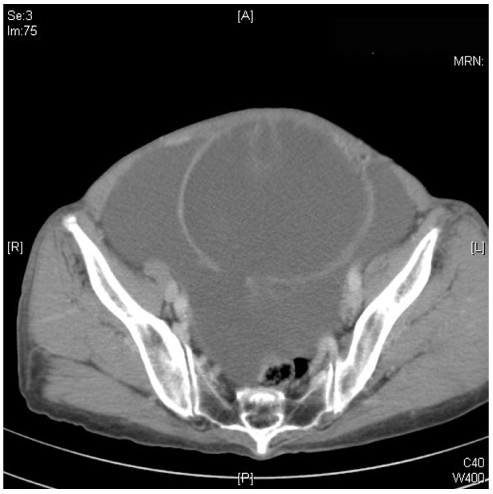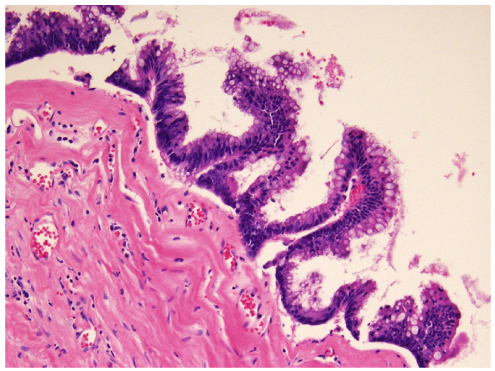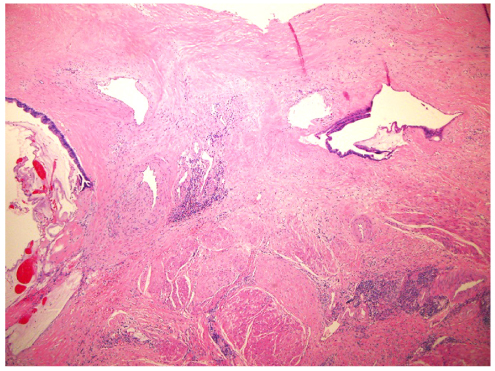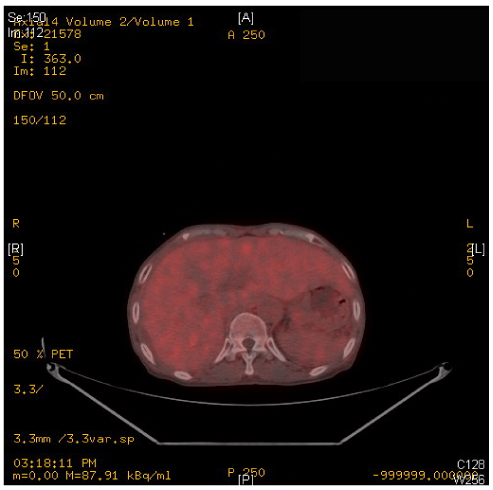Korean J Obstet Gynecol.
2012 Dec;55(12):1010-1014. 10.5468/KJOG.2012.55.12.1010.
A case of pseudomyxoma peritonei associated with borderline mucinous tumor of ovary with invasive metastasis of bladder
- Affiliations
-
- 1Department of Obsterics and Gynecology, Wonju Christian Hospital, Yonsei University Wonju College of Medicine, Wonju, Korea. ppdpd@naver.com
- 2Department of Pathology, Wonju Christian Hospital, Yonsei University Wonju College of Medicine, Wonju, Korea.
- KMID: 2274216
- DOI: http://doi.org/10.5468/KJOG.2012.55.12.1010
Abstract
- Pseudomyxoma peritonei (PMP) is an uncommon entity characterized by large amount of mucinous-jelatinous fluid disseminated in abdominal cavity and pelvic cavity with implants on omentum and bowel. The symptoms of this disease are mostly abdominal distension, dyspepsia, and intraabdominal palpable mass. The origin of PMP is under investigation yet, that is known to arise from appendix, ovary mostly. Also it's etiology, treatment, and prognosis are speculative. Rare cases were reported that have invasion to other organ except appendix and ovaries, but we experienced a case of PMP associated with borderline mucinous tumor of ovary with invasive metastasis of bladder. So we report this case with a brief review with literature.
MeSH Terms
Figure
Reference
-
1. Smeenk RM, van Velthuysen ML, Verwaal VJ, Zoetmulder FA. Appendiceal neoplasms and pseudomyxoma peritonei: a population based study. Eur J Surg Oncol. 2008. 34:196–201.2. Ronnett BM, Shmookler BM, Sugarbaker PH, Kurman RJ. Pseudomyxoma peritonei: new concepts in diagnosis, origin, nomenclature, and relationship to mucinous borderline (low malignant potential) tumors of the ovary. Anat Pathol. 1997. 2:197–226.3. Seidman JD, Elsayed AM, Sobin LH, Tavassoli FA. Association of mucinous tumors of the ovary and appendix. A clinicopathologic study of 25 cases. Am J Surg Pathol. 1993. 17:22–34.4. Werth R. Pseudomyxoma peritonei. Arch Gynecol Obstet. 1884. 24:100–118.5. Ronnett BM, Shmookler BM, Diener-West M, Sugarbaker PH, Kurman RJ. Immunohistochemical evidence supporting the appendiceal origin of pseudomyxoma peritonei in women. Int J Gynecol Pathol. 1997. 16:1–9.6. Fernandez RN, Daly JM. Pseudomyxoma peritonei. Arch Surg. 1980. 115:409–414.7. Carmignani CP, Hampton R, Sugarbaker CE, Chang D, Sugarbaker PH. Utility of CEA and CA 19-9 tumor markers in diagnosis and prognostic assessment of mucinous epithelial cancers of the appendix. J Surg Oncol. 2004. 87:162–166.8. Sulkin TV, O'Neill H, Amin AI, Moran B. CT in pseudomyxoma peritonei: a review of 17 cases. Clin Radiol. 2002. 57:608–613.9. Stewart JHt, Shen P, Levine EA. Intraperitoneal hyperthermic chemotherapy for peritoneal surface malignancy: current status and future directions. Ann Surg Oncol. 2005. 12:765–777.10. Gough DB, Donohue JH, Schutt AJ, Gonchoroff N, Goellner JR, Wilson TO, et al. Pseudomyxoma peritonei. Long-term patient survival with an aggressive regional approach. Ann Surg. 1994. 219:112–119.11. Miner TJ, Shia J, Jaques DP, Klimstra DS, Brennan MF, Coit DG. Long-term survival following treatment of pseudomyxoma peritonei: an analysis of surgical therapy. Ann Surg. 2005. 241:300–308.12. Misdraji J, Yantiss RK, Graeme-Cook FM, Balis UJ, Young RH. Appendiceal mucinous neoplasms: a clinicopathologic analysis of 107 cases. Am J Surg Pathol. 2003. 27:1089–1103.13. Jones CM 3rd, Homesley HD. Successful treatment of pseudomyxoma peritonei of ovarian origin with cis-platinum, doxorubicin, and cyclophosphamide. Gynecol Oncol. 1985. 22:257–259.14. Chua TC, Moran BJ, Sugarbaker PH, Levine EA, Glehen O, Gilly FN, et al. Early- and long-term outcome data of patients with pseudomyxoma peritonei from appendiceal origin treated by a strategy of cytoreductive surgery and hyperthermic intraperitoneal chemotherapy. J Clin Oncol. 2012. 30:2449–2456.15. Verwaal VJ, van Tinteren H, Ruth SV, Zoetmulder FA. Toxicity of cytoreductive surgery and hyperthermic intra-peritoneal chemotherapy. J Surg Oncol. 2004. 85:61–67.
- Full Text Links
- Actions
-
Cited
- CITED
-
- Close
- Share
- Similar articles
-
- A Case of Pseudomyxoma Peritonei with Primary Borderline Mucinous Tumors of the Ovary and Appendix
- A Case of Pseudomyxoma Peritonei Associated with Borderline Mucinous Tumor of Both Ovaries and Appendix
- A Case of Pseudomyxoma Peritonei
- A Case of Pseudomyxoma Peritonei
- Mucinous Tumors of the Appendix Associated with Mucinous Tumors of the Ovary and Pseudomyxoma Peritonei: A Clinicopathologic Analysis of 5 Cases Supporting an Appendiceal Origin






